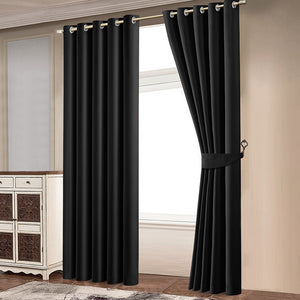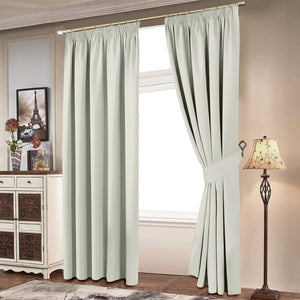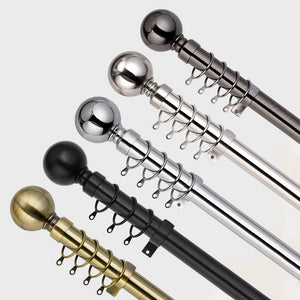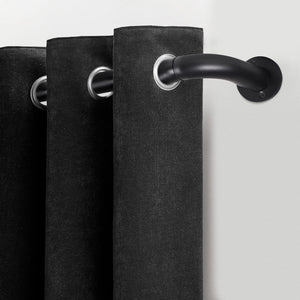How To Measure Curtain Length And Width Correctly?
Choosing the right curtains for your windows is an essential aspect of interior design, but measuring curtain length and width can be a daunting task for many. An ill-fitted curtain not only affects the aesthetics of the room but also compromises its functionality.
In this guide, we will explore the intricacies of correctly measuring curtain length and width, considering different curtain styles, window types, and additional considerations.
Choosing the Right Curtain Style
Before delving into measurements, choosing the right curtain style for your space is crucial. Each style contributes to the room's overall look and impacts how curtains need to be measured. Here are some popular curtain styles to consider:
1. Eyelet Curtains

Eyelet curtains feature metal rings that slide directly onto the curtain rod. They offer a contemporary and streamlined look, making them easy to open and close.
2. Pencil Pleat Curtains

Pencil pleat curtains have tightly gathered folds at the top, resembling a row of pencils. These curtains suit both traditional and modern decor.
3. Tab Top Curtains

Tab top curtains have fabric loops sewn onto the top, through which the curtain rod passes. They provide a casual and relaxed appearance.
4. Ring Top Curtains

Ring top curtains have grommets or rings attached to the fabric, creating a modern and sophisticated appearance. They slide easily on the curtain rod.
5. Grommet Curtains

Like ring-top curtains, grommet curtains have metal rings, usually larger, reinforcing the holes through which the curtain rod passes.
6. Tie-Top Curtains

Tie-top curtains have fabric ties at the top, allowing you to secure them to the curtain rod with bows. This style offers a charming and airy look.
Measuring Curtain Length
Now that you have selected your preferred curtain style, it's time to measure the length accurately. The length of your curtains depends on your chosen style and the desired look for your space. Here are the common curtain lengths:
A. Floor-Length Curtains
For a classic and elegant look, floor-length curtains are a popular choice. Measure from the top of the curtain rod to the floor. Ensure that the curtains barely touch the floor for a clean finish.
B. Sill-Length Curtains
Sill-length curtains typically end at the windowsill. Measure from the top of the curtain rod to the sill, leaving a small gap for a polished appearance.
C. Below Sill-Length Curtains
For a more dramatic effect, curtains can extend below the sill. Measure from the top of the curtain rod to a few inches below the sill for a stylish and elongated appearance.
Measuring Curtain Width
The width of your curtains is equally important and depends on factors such as the type of curtain panels, fullness factor, and the width of your window.
A. Single Panel vs. Pair of Panels
Decide whether you want a single curtain panel or a pair. Single panels work well for narrow windows, while pairs are suitable for wider windows for a balanced look when the curtains are drawn.
B. Fullness Factor
Fullness refers to the amount of fabric used in the curtain. A general rule is to multiply the width of your window by a factor between 1.5 and 2.5 for a fuller appearance. This ensures that the curtains look rich and luxurious when closed.
C. Considering Window Width
Measure the width of your window accurately. If you opt for a single panel, the width should equal the window's width. For a pair of panels, divide the total width in half and add extra inches for overlap.
How To Measure Windows For Curtains?
Accurate measurements are crucial for well-fitted curtains. The measuring process differs depending on whether you prefer curtains inside or outside the window frame.
A. Inside the Frame Measurements
For a neat and clean look, measure the width and height inside the window frame. Use these measurements for curtains that will hang within the frame.
B. Outside the Frame Measurements
To create a grander appearance or when the window frame is not visually appealing, measure the width and height outside the frame. This allows the curtains to cover the entire window, giving the illusion of a larger space.
Additional Considerations for Special Windows
Special window types require special attention when measuring curtains.
A. Bay Windows
For bay windows, measure the width of each section individually and consider whether you want curtains to cover the entire bay or each section separately. Use a flexible tape measure to follow the contours accurately.
B. Arched Windows
For arched windows, measure the height of the arch at its highest point. Curtains can be installed below the arch or tailored to follow its shape.
C. French Doors
Measure the width and height of the glass part of the French door. Ensure that the curtains do not obstruct the door's functionality.
Tips for Accurate Measurements
To ensure precision in your curtain measurements, consider the following tips:
A. Ensuring Precision
Use a metal tape measure for accuracy, and measure each window individually. Avoid relying on assumed measurements, as windows in the same room can vary.
B. Double-Checking Measurements
Double-check all measurements before finalising your curtain purchase. Mistakes in measurements can lead to ill-fitted curtains that compromise the overall look of your space.
C. Seeking Professional Advice
Consider seeking professional advice if you are still determining or dealing with unique window shapes. Interior designers or curtain specialists can provide valuable insights and ensure a perfect fit.
Common Mistakes to Avoid
Avoiding common mistakes is crucial for achieving your curtains' desired look and functionality.
A. Underestimating Fullness
Ensure you account for the fullness factor when measuring the width of your curtains. Only underestimating this factor can result in curtains that look skimpy when closed.
B. Ignoring Fabric Characteristics
Different fabrics drape differently. Consider the characteristics of the chosen fabric, such as thickness and stiffness, as they can impact how the curtains hang.
C. Neglecting Curtain Style Impact
Each curtain style has its impact on the overall appearance of the room. Neglecting this aspect can lead to a mismatched and uncoordinated look.
Additional Tips for Curtain Maintenance
Maintaining your curtains is essential for preserving their appearance and functionality over time. Here are some additional tips:
1. Regular Dusting
Dust accumulates on curtains, especially in high-traffic areas or homes with open windows. Use a soft brush attachment on your vacuum cleaner or a duster to remove dust regularly.
2. Spot Cleaning
Address any stains or spots promptly to prevent them from setting. Use a mild detergent or spot cleaner suitable for your curtain fabric. Always test in an inconspicuous area first.
3. Professional Cleaning
Consider professional dry cleaning for delicate or intricate fabrics to avoid any damage. Professional cleaners have the expertise to handle various materials without compromising their quality.
4. Rotate Curtains
If your curtains receive direct sunlight, rotate them periodically to ensure even fading. This helps maintain a consistent appearance and extends the lifespan of your curtains.
5. Follow Care Instructions
Always adhere to the care instructions provided by the manufacturer. Different fabrics require specific care, and following these guidelines ensures longevity and optimal performance.
By incorporating these maintenance tips, you can enjoy your curtains for years, preserving their beauty and functionality.
Conclusion
Measuring curtain length and width correctly is essential for achieving a polished and harmonious interior design. By understanding the nuances of curtain styles, window types, and accurate measurements, you can confidently choose and install curtains that enhance the beauty of your space. Take the time to measure meticulously, avoid common mistakes, and seek professional advice when needed. With the right curtains, your windows will look stunning and function seamlessly.
FAQs
What Are The Common Mistakes In Curtain Measurements?
Common mistakes include underestimating fullness, ignoring fabric characteristics, and neglecting the curtain style's impact on the room's overall look. Precision is key when measuring curtains.
How Do I Measure For Bay Windows?
Measure the width of each section individually for bay windows. Decide whether you want curtains to cover the entire bay or each section separately. Use a flexible tape measure to follow the contours accurately.
How Do I Choose The Right Fabric For My Curtains?
Choosing the right fabric is crucial for achieving the desired look and functionality. Consider factors such as the room's purpose, the amount of natural light, and the desired level of privacy. Heavier fabrics like velvet or brocade provide better insulation and light-blocking, while lighter fabrics like linen or cotton lend an airy feel.
Can I Use Curtain Accessories To Enhance The Appearance?
Yes, curtain accessories can elevate the overall look of your window treatments. Consider using tiebacks, valances, or decorative rods to add a touch of sophistication. However, ensure these accessories complement the room's curtain style and overall theme.
How Often Should I Clean My Curtains?
The frequency of curtain cleaning depends on various factors, such as the fabric type, exposure to dust, and household activities. Generally, it's advisable to clean curtains every 3-6 months. Check the care instructions for your specific curtain fabric before cleaning, as some materials may require special care.








